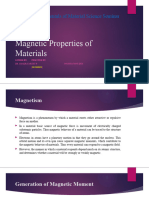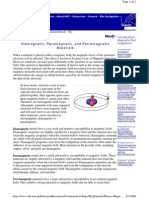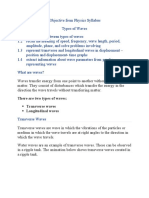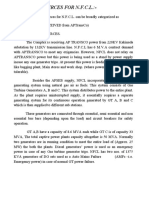0 ratings0% found this document useful (0 votes)
200 viewsProperties of Solid: Magnetic Property of Solids
Properties of Solid: Magnetic Property of Solids
Uploaded by
sharadThe magnetic properties of solids depend on the magnetic properties of their constituent atoms and ions. Electrons in atoms have orbital and spin motions that create magnetic fields. Solids can be paramagnetic, meaning they are weakly magnetized in the same direction as an external magnetic field but do not retain magnetism after removal from the field. They can also be diamagnetic, meaning they are weakly magnetized in the opposite direction of an external magnetic field. Ferromagnetic solids are strongly magnetized in the same direction as an external field and can retain magnetism after its removal due to magnetic domains within the material. Antiferromagnetic solids have oppositely aligned domains that cancel out their overall magnetism.
Copyright:
© All Rights Reserved
Available Formats
Download as PPTX, PDF, TXT or read online from Scribd
Properties of Solid: Magnetic Property of Solids
Properties of Solid: Magnetic Property of Solids
Uploaded by
sharad0 ratings0% found this document useful (0 votes)
200 views12 pagesThe magnetic properties of solids depend on the magnetic properties of their constituent atoms and ions. Electrons in atoms have orbital and spin motions that create magnetic fields. Solids can be paramagnetic, meaning they are weakly magnetized in the same direction as an external magnetic field but do not retain magnetism after removal from the field. They can also be diamagnetic, meaning they are weakly magnetized in the opposite direction of an external magnetic field. Ferromagnetic solids are strongly magnetized in the same direction as an external field and can retain magnetism after its removal due to magnetic domains within the material. Antiferromagnetic solids have oppositely aligned domains that cancel out their overall magnetism.
Original Title
PROPERTIES OF SOLID
Copyright
© © All Rights Reserved
Available Formats
PPTX, PDF, TXT or read online from Scribd
Share this document
Did you find this document useful?
Is this content inappropriate?
The magnetic properties of solids depend on the magnetic properties of their constituent atoms and ions. Electrons in atoms have orbital and spin motions that create magnetic fields. Solids can be paramagnetic, meaning they are weakly magnetized in the same direction as an external magnetic field but do not retain magnetism after removal from the field. They can also be diamagnetic, meaning they are weakly magnetized in the opposite direction of an external magnetic field. Ferromagnetic solids are strongly magnetized in the same direction as an external field and can retain magnetism after its removal due to magnetic domains within the material. Antiferromagnetic solids have oppositely aligned domains that cancel out their overall magnetism.
Copyright:
© All Rights Reserved
Available Formats
Download as PPTX, PDF, TXT or read online from Scribd
Download as pptx, pdf, or txt
0 ratings0% found this document useful (0 votes)
200 views12 pagesProperties of Solid: Magnetic Property of Solids
Properties of Solid: Magnetic Property of Solids
Uploaded by
sharadThe magnetic properties of solids depend on the magnetic properties of their constituent atoms and ions. Electrons in atoms have orbital and spin motions that create magnetic fields. Solids can be paramagnetic, meaning they are weakly magnetized in the same direction as an external magnetic field but do not retain magnetism after removal from the field. They can also be diamagnetic, meaning they are weakly magnetized in the opposite direction of an external magnetic field. Ferromagnetic solids are strongly magnetized in the same direction as an external field and can retain magnetism after its removal due to magnetic domains within the material. Antiferromagnetic solids have oppositely aligned domains that cancel out their overall magnetism.
Copyright:
© All Rights Reserved
Available Formats
Download as PPTX, PDF, TXT or read online from Scribd
Download as pptx, pdf, or txt
You are on page 1of 12
PROPERTIES OF SOLID
XII
Magnetic Property of Solids
The magnetic properties of a solid are the result
of the magnetic property of the atoms or ions of
these solids.
Magnetism and magnetization of a solid will depend on the
movement of electrons in an atom.
This magnetic behaviour of the electrons of an atom is due
to the movement patterns. They have specifically two
types of movements,
•Electrons revolve around the nucleus of the atom
•Electrons also spin on their own axis, spins in opposite
sides are labelled with + and – signs.
These constant motions make an electric field around the
electrons, almost like a loop of current which lends it its
magnetic property.
On the basis of their magnetic properties, solids can be classified
into five categories.
Paramagnetic
These substances are weakly magnetized in an external magnetic field.
The direction is the same direction of the magnetic field. So they gain a
net magnetization
When we remove the paramagnetic substance from the field, the
alignment of electrons is interrupted and the substance will lose its
magnetic property.
Thus paramagnetic substances are not permanent magnets.
Diamagnetic
Just like paramagnetism, in diamagnetism too the substances
are magnetized in an external magnetic field. But diamagnetic
solids are repelled in the field. The magnetic property effected
in them is in the opposite direction of the magnetic fields and
thus they have a repulsive force.
In diamagnetic substances, all electrons in their last shell are
paired, there are no unpaired valence electrons. This is the
reason that the magnetic moment of their atoms is nearly zero.
Examples are substances like Sodium Chloride, B
Ferromagnetic
Now, these solids are strongly magnetized when we place them
in an external magnetic field. Besides the very strong attraction
forces, these solids can actually be magnetized permanently.
This means that even when the external magnetic fields are
removed the solids will retain their magnetic properties.
It is a widely believed theory that the ferromagnetic structures
have certain special characteristics. They have what we call
“domains’ which is a special grouping of metal ions. Each
domain is similar to a small magnet. In an electromagnetic
field, these domains rearrange themselves and align themselves
with the magnetic field. In a non-magnetized metal, these
domains are randomly arranged and it cancels out their
magnetic properties.
The examples of ferromagnetic solids include Cobalt, Nickel,
Chromium Oxide etc.
Antiferromagnetic
In antiferromagnetism, the domain structures of the solid are
very similar to those of ferromagnetic solids. But here the
domains are oppositely oriented. This means they cancel out
each other’s magnetism.
Ferrimagnetic
These substances occur when magnetic moments are aligned in
both directions (parallel as well as anti-parallel) but in unequal
numbers. These are weakly attracted to magnetic fields. Also on
heating, these substances will lose their ferrimagnetism
altogether.
You might also like
- Magnetic Particle TestingDocument34 pagesMagnetic Particle Testingmnaseemiqbal4200No ratings yet
- Basic Electricity ReviewerDocument3 pagesBasic Electricity Reviewercircuitor201283% (6)
- SNM 05Document7 pagesSNM 05Mazhar AliNo ratings yet
- Magnetic FieldDocument2 pagesMagnetic Fieldkhopo ALzainNo ratings yet
- Magnetic Properties of SolidsDocument2 pagesMagnetic Properties of SolidsZunair ArslanNo ratings yet
- Physics ProjectDocument10 pagesPhysics ProjectMandeep TanwarNo ratings yet
- Magnetic MeterialsDocument1 pageMagnetic MeterialsmpkkbtechNo ratings yet
- Paramagnetism: Heuristic Bohr-Van Leeuwen Theorem Quantum-MechanicalDocument3 pagesParamagnetism: Heuristic Bohr-Van Leeuwen Theorem Quantum-MechanicalAMITAVA RAYNo ratings yet
- Phy DiamagneticDocument2 pagesPhy DiamagneticB BoysNo ratings yet
- Basic Principles of MPI TestingDocument48 pagesBasic Principles of MPI TestingManivannanMudhaliarNo ratings yet
- Magnetism and Matter ProjectDocument15 pagesMagnetism and Matter ProjectSubash ChandNo ratings yet
- Magnetic PropertiesDocument6 pagesMagnetic Propertiesrajasuleman335No ratings yet
- Advanced Morden Solid State Physics 4Document9 pagesAdvanced Morden Solid State Physics 4Edge of ScenesNo ratings yet
- Ch-5 Magnetism and MatterDocument3 pagesCh-5 Magnetism and Mattertharunpearl76No ratings yet
- Physics FinalDocument14 pagesPhysics FinalBhavadarshiniNo ratings yet
- Machines Lab No. 1Document7 pagesMachines Lab No. 1Marvin Lucero FiscalNo ratings yet
- MPTDocument33 pagesMPTsanthoshm123098No ratings yet
- Cbse 12th Physics Chapter 5 Magnetism and Matter Class 12 NotesDocument3 pagesCbse 12th Physics Chapter 5 Magnetism and Matter Class 12 Notesmanas101006No ratings yet
- Cbse 12th Physics Chapter 5 Magnetism and Matter Class 12 NotesDocument3 pagesCbse 12th Physics Chapter 5 Magnetism and Matter Class 12 NotesManas SinghNo ratings yet
- SCIENCEDocument7 pagesSCIENCEJheiah UyNo ratings yet
- MagnetismDocument20 pagesMagnetismmadhumitharajNo ratings yet
- MagnetismDocument2 pagesMagnetismIbukun OlaitanNo ratings yet
- G-9 Chapter 8 PhysicsDocument4 pagesG-9 Chapter 8 PhysicsAsifa AkhterNo ratings yet
- Magnet AssignmentDocument2 pagesMagnet Assignmentlamsen110300No ratings yet
- Form5 Unit1 Magnetism NotesDocument10 pagesForm5 Unit1 Magnetism NotesJus BetikNo ratings yet
- CH 7 MagnetismDocument8 pagesCH 7 MagnetismAnkit Singh RathoreNo ratings yet
- Electric and Magnetic Fields (2) - Lecture 1 Spring 2021-2022Document21 pagesElectric and Magnetic Fields (2) - Lecture 1 Spring 2021-2022Ahmed tarek gaballahNo ratings yet
- 2021 - Types of Magnets - Monday 22nd NovemberDocument14 pages2021 - Types of Magnets - Monday 22nd NovemberSheldon MusiinzaNo ratings yet
- Science PPT MagnetsDocument8 pagesScience PPT Magnetsapi-313062442No ratings yet
- Compass For OOW Class IIIDocument260 pagesCompass For OOW Class IIIKyaw Mya OoNo ratings yet
- Sri Ramayanti - Tugas 2Document18 pagesSri Ramayanti - Tugas 2Sri Ramayanti SimanjuntakNo ratings yet
- Magnetic Particle TestingDocument35 pagesMagnetic Particle TestingWALIDNo ratings yet
- MPI - Magnetic Particle Inspection PresentationDocument64 pagesMPI - Magnetic Particle Inspection Presentationmahesh070100% (1)
- Magnetism Arises From Two Types of Motions of Electrons in AtomsDocument4 pagesMagnetism Arises From Two Types of Motions of Electrons in AtomsSajesh VallikkadanNo ratings yet
- Physics Project MagnetismDocument27 pagesPhysics Project MagnetismDheekshith KumarNo ratings yet
- What Is MagnetDocument9 pagesWhat Is Magnetarsc123No ratings yet
- Pawan ChoudharyDocument33 pagesPawan Choudharyraianiket088No ratings yet
- Unit 5 MagnetismDocument17 pagesUnit 5 MagnetismTofe YusufNo ratings yet
- Magnetism Part 1Document8 pagesMagnetism Part 1AnonymousNo ratings yet
- Assignment of PhysicsDocument35 pagesAssignment of PhysicsArnab NathNo ratings yet
- MagnitisumDocument22 pagesMagnitisumPrakhar VermaNo ratings yet
- Magnetism IGCSE PhysicsDocument44 pagesMagnetism IGCSE PhysicsKavya KothariNo ratings yet
- DiamagnetismDocument6 pagesDiamagnetismMis ter StudenttNo ratings yet
- Magnetism 2Document27 pagesMagnetism 2ArahNo ratings yet
- Magnets and Magnetism Summary and NotesDocument2 pagesMagnets and Magnetism Summary and Noteszanzoon20000No ratings yet
- Who Invented Magnets?Document5 pagesWho Invented Magnets?Mhea Nicole EscubidoNo ratings yet
- 3.10 MagnetismDocument8 pages3.10 MagnetismArun RajeevNo ratings yet
- Simple Phenomena of Magnetism - Free Exam AcademyDocument1 pageSimple Phenomena of Magnetism - Free Exam AcademyMisheel BatzorigNo ratings yet
- In A Flash: Magnets and ElectricityDocument20 pagesIn A Flash: Magnets and ElectricityJohn Paul BaquiranNo ratings yet
- Form 3 Physics MagnetsDocument6 pagesForm 3 Physics MagnetsChibale Mchere BandaNo ratings yet
- Magnet Presentation - EMT PhysicsDocument24 pagesMagnet Presentation - EMT PhysicsletsjoyNo ratings yet
- Magnetic Properties of Materials DocsDocument6 pagesMagnetic Properties of Materials DocsJeterine AriasNo ratings yet
- Magnetic Properties of MaterialsDocument31 pagesMagnetic Properties of MaterialssoumyajyotideyNo ratings yet
- 06-Feb-2020 Introduction To Magnetism and Magnetic MaterialsDocument31 pages06-Feb-2020 Introduction To Magnetism and Magnetic MaterialsATULYA ALOK 17BEE0065No ratings yet
- Magnetism and Electromagnetism Review2Document35 pagesMagnetism and Electromagnetism Review2Kenneth JacksonNo ratings yet
- Diamagnetic, Paramagnetic, and Ferromagnetic Materials: Home - Education Resources - NDT Course Material - MPIDocument2 pagesDiamagnetic, Paramagnetic, and Ferromagnetic Materials: Home - Education Resources - NDT Course Material - MPIheartbreakkid132No ratings yet
- Basic MagnetismDocument13 pagesBasic Magnetismnadjat_21100% (1)
- Physics for Kids : Electricity and Magnetism - Physics 7th Grade | Children's Physics BooksFrom EverandPhysics for Kids : Electricity and Magnetism - Physics 7th Grade | Children's Physics BooksRating: 5 out of 5 stars5/5 (1)
- The Attractive Story of Magnetism with Max Axiom Super Scientist: 4D An Augmented Reading Science ExperienceFrom EverandThe Attractive Story of Magnetism with Max Axiom Super Scientist: 4D An Augmented Reading Science ExperienceNo ratings yet
- Soilid PkingDocument21 pagesSoilid PkingsharadNo ratings yet
- Use of ArticleDocument7 pagesUse of ArticlesharadNo ratings yet
- What Is A VerbDocument4 pagesWhat Is A VerbsharadNo ratings yet
- Parts of Speech - NounDocument13 pagesParts of Speech - Nounsharad100% (1)
- Theory of Communication and Types of CommunicationDocument3 pagesTheory of Communication and Types of CommunicationsharadNo ratings yet
- 02 Ordinary Levelling ConceptDocument22 pages02 Ordinary Levelling ConceptIsraa AhmedNo ratings yet
- Physics JEE Main 2023 Chapterwise PYQs PDFDocument70 pagesPhysics JEE Main 2023 Chapterwise PYQs PDFSrishant KumarNo ratings yet
- Comment On "A Generalized Helmholtz Theorem For Time-Varying Vector Fields," by Artice M. DavisDocument3 pagesComment On "A Generalized Helmholtz Theorem For Time-Varying Vector Fields," by Artice M. Davisfersoto07No ratings yet
- EDC-M9102 Detector Manual F3.780.1099ASY Issue1.01Document2 pagesEDC-M9102 Detector Manual F3.780.1099ASY Issue1.01EDWIN100% (1)
- GM 2000 EacfDocument36 pagesGM 2000 EacfGediminas LinkusNo ratings yet
- Switching-In Transients in TransformerDocument2 pagesSwitching-In Transients in Transformersabarna.saha1308No ratings yet
- 3D Catalog HG11 31 enDocument47 pages3D Catalog HG11 31 enqwkerbk090909No ratings yet
- MCQ of All Chapters 2nd Puc PhysicsDocument58 pagesMCQ of All Chapters 2nd Puc PhysicsSajjan KamalNo ratings yet
- Be3251 Basic Electrial, Electronics and Engineering: Important Questions and Question BankDocument8 pagesBe3251 Basic Electrial, Electronics and Engineering: Important Questions and Question BankSatheeswaran V100% (1)
- Uee AnmDocument140 pagesUee AnmsatyaNo ratings yet
- 12.2 HVDC Proven TechnologyDocument48 pages12.2 HVDC Proven TechnologyJean Baptiste nkongoloNo ratings yet
- Me Sci 8 q1 0704 PsDocument24 pagesMe Sci 8 q1 0704 PsGlydel PototNo ratings yet
- FXW Hand-Held CommunicatorDocument4 pagesFXW Hand-Held CommunicatorIsthiaq ahmedNo ratings yet
- There Are Two Types of WavesDocument5 pagesThere Are Two Types of WavesJahleel TroupeNo ratings yet
- Eskom Servitude GuidelineDocument96 pagesEskom Servitude GuidelineTafadzwa MurwiraNo ratings yet
- 1.1 FEB 423 - Introduction To Heat and Mass TransferDocument13 pages1.1 FEB 423 - Introduction To Heat and Mass TransferKingsley CassityNo ratings yet
- Physics PROJECT: Maharishi Vidya MandirDocument23 pagesPhysics PROJECT: Maharishi Vidya MandirSubhankar BorahNo ratings yet
- Tendrs Published On WebsiteDocument728 pagesTendrs Published On WebsiteSantosh Kumar PatnaikNo ratings yet
- Power Sources For N.F.C.L.Document19 pagesPower Sources For N.F.C.L.srinivasvemprala2No ratings yet
- Esc6 - TWX6081K & TWX6081KBDocument2 pagesEsc6 - TWX6081K & TWX6081KBSajjadNo ratings yet
- 789C Electrical UENR2448UENR2448-00Document8 pages789C Electrical UENR2448UENR2448-00mirbek mairykovNo ratings yet
- Rish Relay Voltage PDFDocument8 pagesRish Relay Voltage PDFSergio LorenzoNo ratings yet
- CLMD4A AutomotiveG9 10Document25 pagesCLMD4A AutomotiveG9 10Eiay CommsNo ratings yet
- BER, Controls Motorized Valve Start-Up InstructionsDocument6 pagesBER, Controls Motorized Valve Start-Up InstructionsJoseph YumulNo ratings yet
- 62dfade9dbe3f100116c0e27 - ## - Current Electricity - Short Notes - (Only PDFDocument35 pages62dfade9dbe3f100116c0e27 - ## - Current Electricity - Short Notes - (Only PDFYuvraj TripathiNo ratings yet
- Single Turn Wire Wound Potentiometer, R.W-3: Make in India Make in IndiaDocument2 pagesSingle Turn Wire Wound Potentiometer, R.W-3: Make in India Make in IndiaDarshan MakwanaNo ratings yet
- IGCSE Physics Data & Formulae v02Document4 pagesIGCSE Physics Data & Formulae v02bernicewpyhkNo ratings yet
- UG Physics NEP 2020 FinalDocument56 pagesUG Physics NEP 2020 FinalBhardwaj Shivani SinghNo ratings yet
- Practical Manual On Remote Sensing, GIS and Land Use PlanningDocument124 pagesPractical Manual On Remote Sensing, GIS and Land Use Planningfranz kafkaNo ratings yet






























































































